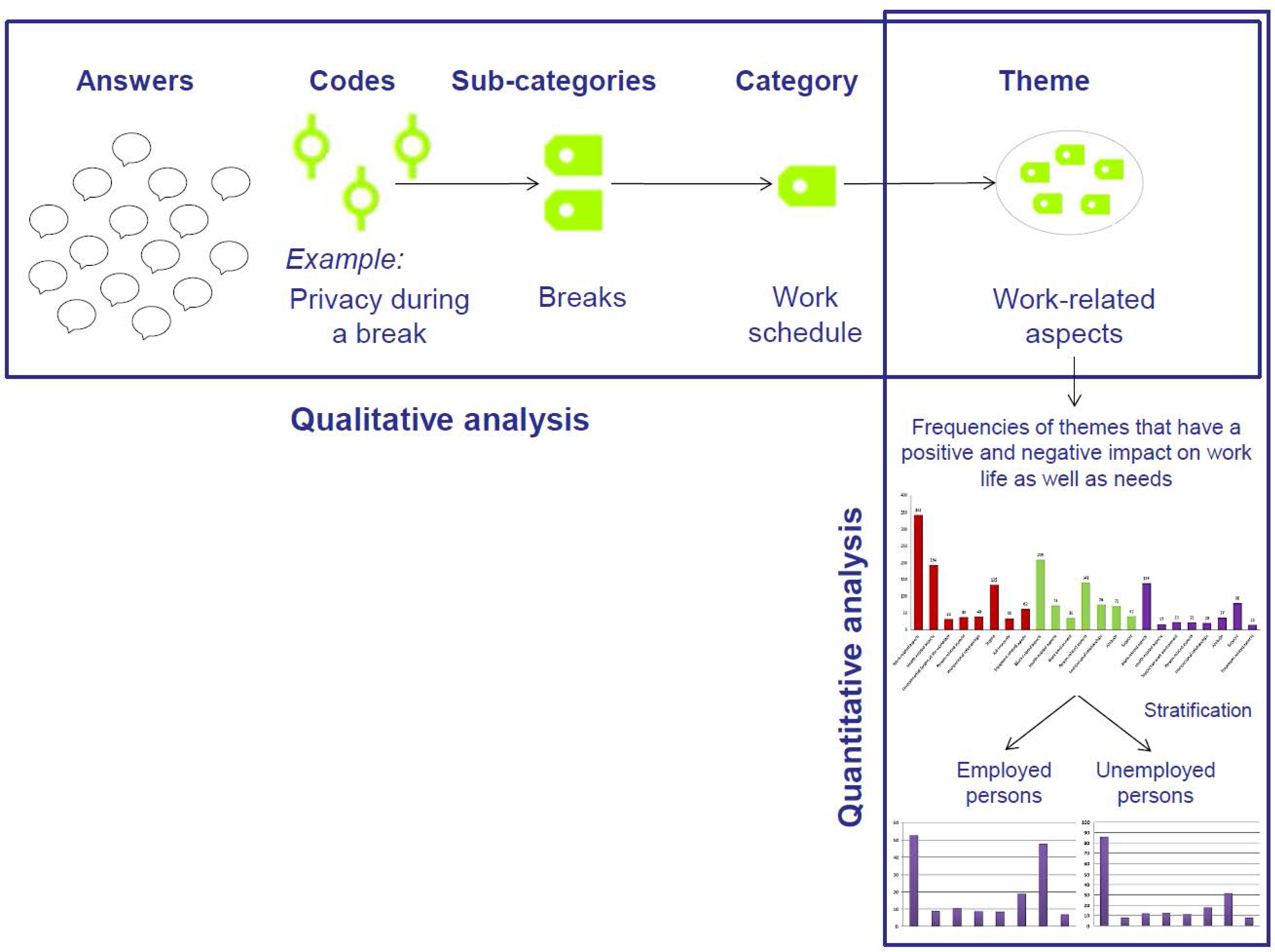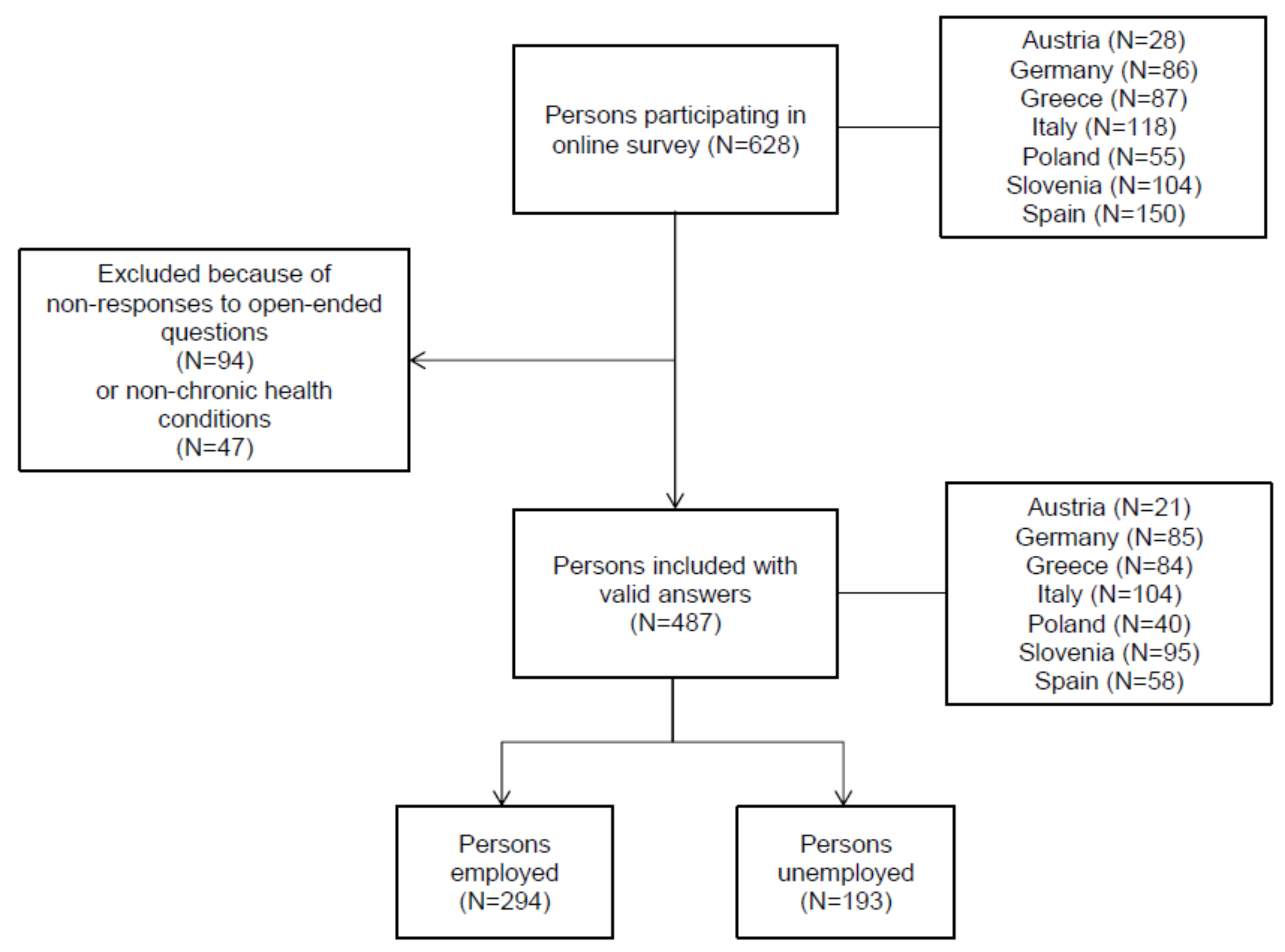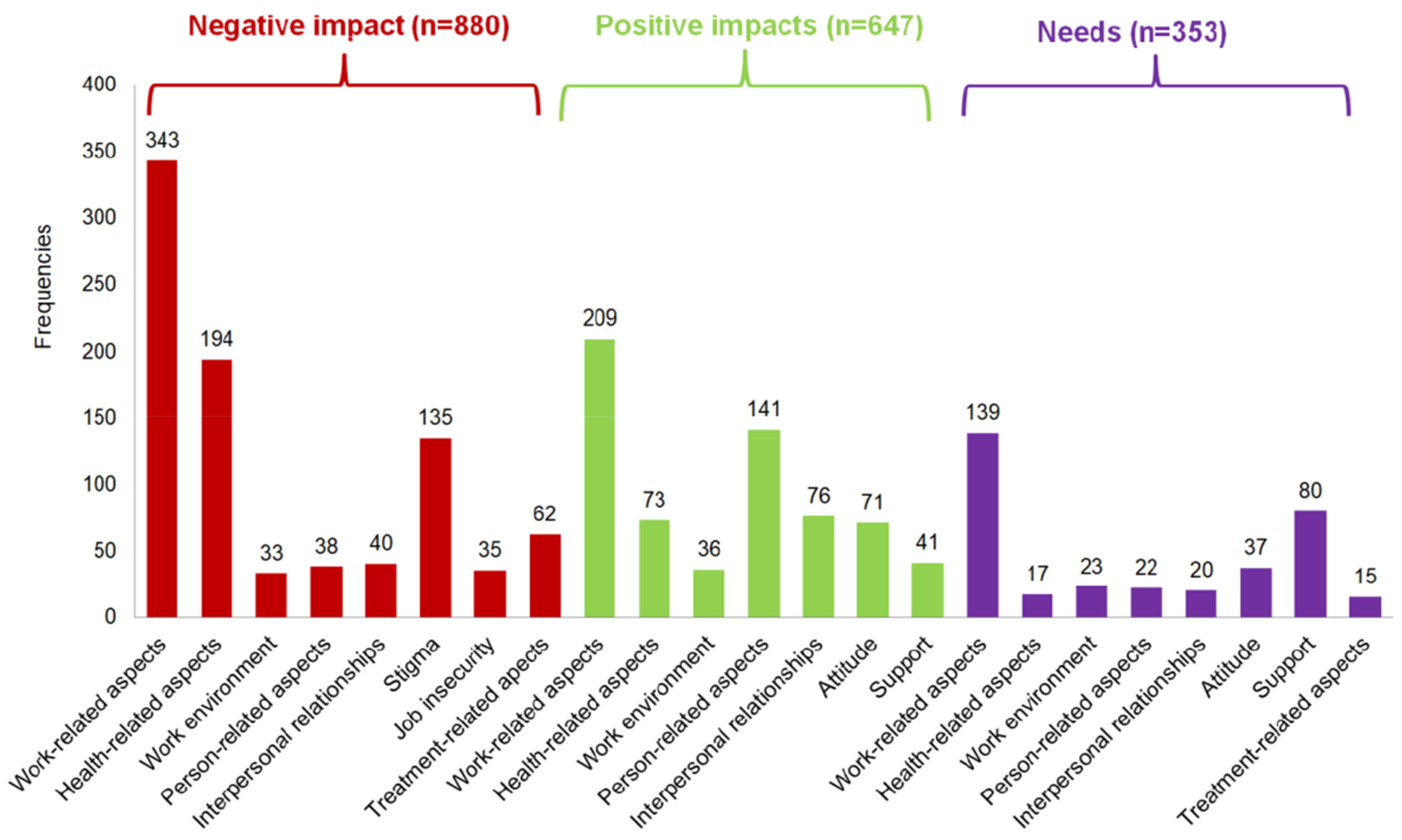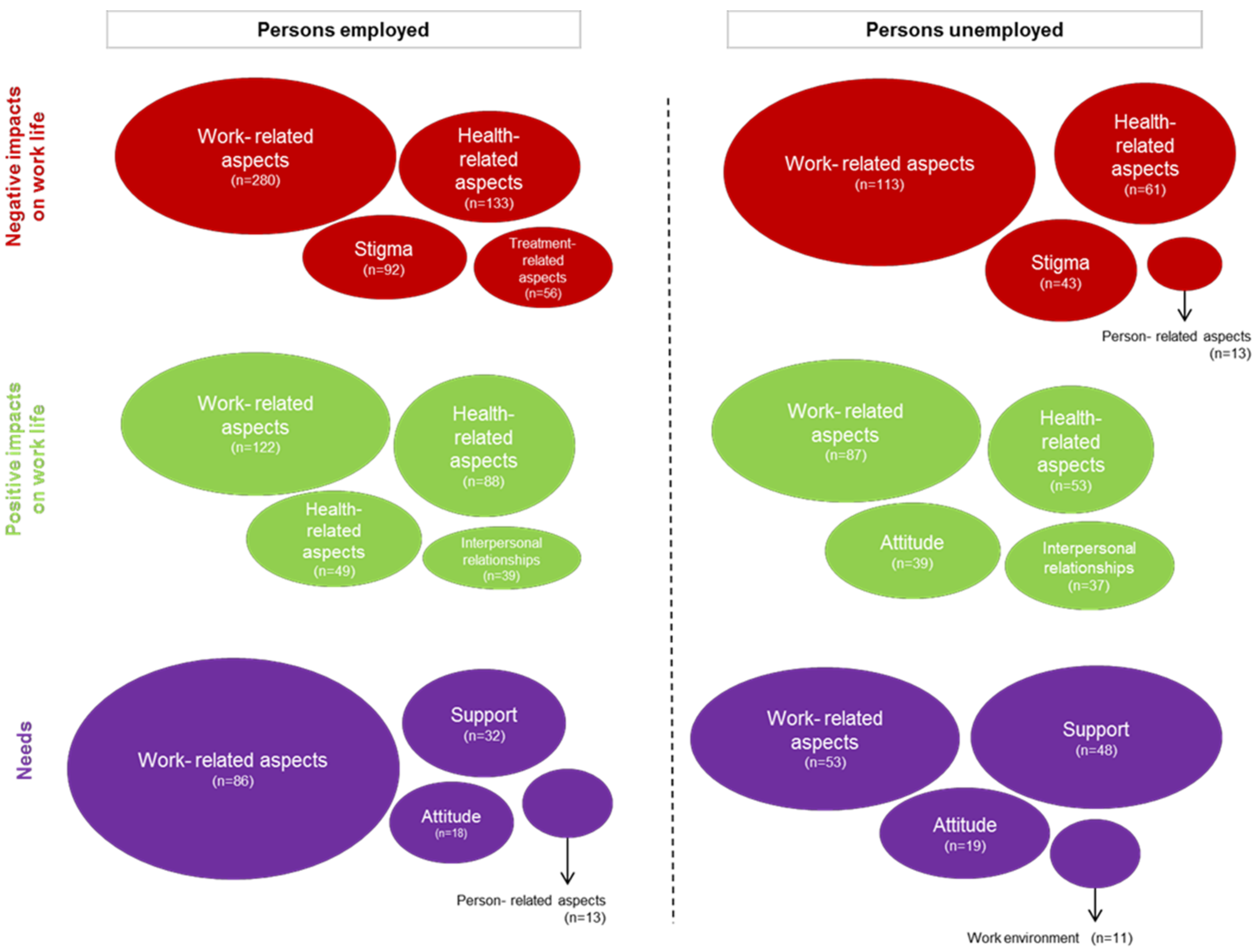What Persons with Chronic Health Conditions Need to Maintain or Return to Work—Results of an Online-Survey in Seven European Countries
Abstract
:1. Introduction
2. Materials and Methods
2.1. Design
2.2. Participants
2.3. Material
2.4. Data Collection and Data Preparation
2.5. Data Analysis
3. Results
3.1. Description of Study Participants
3.2. Factors Having a Positive or Negative Impact and Needs
3.2.1. Factors Having a Negative Impact on Work Life
- “Work-related aspects”: Categories of this theme are Career development, Food at the canteen Home-work interface, Stress, Workplace, Work structure, Work schedule as well as Workload and work pace. Career development resulted from the participants’ view of having difficult advancement opportunities when having a chronic health condition.
“Difficult advancement opportunities”(54, female, Germany, employed, migraine/headache disorders)
“Lack of real opportunities”(50, female, Poland, employed, depression; migraine)
“Lack of development”(28, male, Poland, employed, DM)
“Too much stress load”(58, male, Slovenia, employed, COPD)
“Stress; periods, when I cannot even rest because of my breathing problems and I have to work “like crazy””(62, male, Slovenia, employed, COPD)
“That I couldn’t reveal the fact that I was fighting with depression which resulted in being under stress and pressure”(49, female, Greece, unemployed, depression)
“Daily stress in order to be able to complete all my duties with responsibility and consistency”(34, female, Greece, employed, depression)
“Too many duties”(28, male, Poland, unemployed, DM)
“Incapable of achieving the high standards, set by employer”(43, male, Slovenia, employed, migraine/headache disorders)
“When sometimes I have to work for many hours without resting because the company is mine and I have to be there all the time”(61, male, Greece, employed, COPD)
“I have to perform my job in the same time as my colleagues, but at the same time I have to manage my disease”(31, female, Italy, employed, DM)
“Having no breaks in case of worsening of my disease”(58, female, Poland, unemployed, depression)
“Overload resulting from “duty” to sit at the desk even when there was no work to be done”(31, female, Poland, employed, depression)
“Start to work early in the morning because I often have nocturnal and early morning crises”(51, female, Italy, employed, migraine/headache disorder; back and neck pain)
- “Health-related aspects”: The theme “Health-related aspects” include issues mainly focusing on impaired body functions as defined by the International Classification of Functioning, Disability and Health (ICF) [18] and diagnoses. With regard to impaired body functions, study participants stressed problems with concentration, emotional functions and disfigurement of the body or body parts.
“Anxiety that I can’t discharge my duties at work because of my mood”(52, female, Poland, unemployed, depression)
“Anxiety whenever I could not go to work because of the intensity of my symptoms—something that could result in my dismissal”(49, female, Greece, unemployed, depression; IHD)
- “Stigma”: The study participants reported on Stigmatization as one of the Factors having a negative impact that is hard to deal with at their workplace. The experiences of discrimination reported by the persons involved in our study are related to a lack of knowledge or understanding of their chronic health conditions. Stigma, as defined by Thornicroft and colleagues [19], is specified in the three parts, Knowledge, Attitudes and Behavior. The study participants often named problems with colleagues or supervisors due to a lack of knowledge and understanding that led to conflicts, discrimination and maladjustment.
“Lack of understanding of chronic health condition by supervisors and colleagues”(36, female, Germany, employed, depression)
“Always being the one with the “sickness bonus”(22, female, Austria, employed, DM)
“I was always referred to as “not fully deployable, fit or able to perform”(67, male, Austria, unemployed, COPD; IHD)
“Misunderstanding from managers and ignorance about the disease”(58, female, Slovenia, unemployed, back and neck pain)
“The fact that most of my colleagues and supervisors do not pay attention to my health situation and they continue to load me with more responsibilities, while they see that I cannot keep up”(34, female, Greece, employed, depression)
3.2.2. Factors Having a Positive Impact on Work Life
- “Work-related aspects”: One of the categories derived from this theme is having a standard salary. Also the aspect of having enough income to finance treatments or medications was mentioned by the study participants as a Factor having a positive impact on their work lives.
“With that income I can afford quite a lot that contributes to my own and my family’s physical, mental and emotional well-being”(50, male, Austria, employed, DM)
“Certainly the fact that I have a regular salary every month and I can pay doctors and medications, makes me feel safe”(34, female, Greece, employed, depression)
“Many years in the same company and a stable position”(50, female, Poland, employed, depression, migraine/headache disorders)
“I have permanent contract”(50, male, Italy, employed, COPD)
“I have obtained a part-time work”(51, female, Italy, employed, migraine/headache disorders)
“My own design of the working day”(52, female, Germany, employed, migraine/headache disorders)
“A job with diverse tasks, with external operations (not always inside the office)”(37, female, Spain, unemployed, DM)
“To be able to take a break or leave when I need to (flexible hours)”(62, male, Greece, employed, COPD)
“A daily routine meant that time was passing more easily, and I was not thinking of the difficulties”(54, female, Greece, unemployed, COPD)
- “Person-related aspects”: This theme is an important factor for coping with a chronic health condition. Most of the answers are categorized in Thoughts and beliefs and Motives such as the person’s needs and goals. Another aspect of this theme having a positive impact on work life is Feelings and emotions of persons and their position in the social context. Almost half of the “Person-related aspects” deal with codes coming from the category Thoughts and beliefs. Most of them are resources that help to deal with a chronic health condition such as “being creative”, “being calm”, “positive thinking”, “self-discipline” and “self-esteem” to name just some of them.
“I am motivated every day to perform as well as a healthy employee”(63, female, Austria, employed, COPD; migraine/headache disorders)
“Creativity and continuous mind functioning”(49, female, Greece, unemployed, depression)
“Partial possibility of self-fulfillment (it’s better than sitting at home and having nothing to do)”(28, male, Poland, employed, DM)
“Physical work activity has been beneficial”(61, male, Spain, unemployed, DM)
- “Interpersonal relationships”: Relationships with colleagues and supervisors play an important role in the integration in the workplace. The study participants expressed their perception of being a part of the team or company. Factors having a positive impact that were often named by the study participants included Communication with people and having a Good atmosphere at the workplace.
“Meeting a lot of people and the opportunity to earn for myself”(28, male, Poland, employed, DM)
“Positive and balanced relations with my co-workers”(31, female, Slovenia, employed, DM)
“Something positive in general, was the communication with my colleagues”(43, male, Greece, unemployed, IHD)
3.2.3. Needs to Maintain or Return to Work
- “Work-related aspects”: Nearly half of the Needs of people with chronic health conditions deal with “Work-related aspects”. One of these “Work-related aspects” was Work schedule; the study participants stressed the need, variously, to work without interruption, have flexible working models, working hours and fixed or flexible breaks.
“Offer flexible working models and accept needs”(53, male, Germany, employed, depression)
“Consideration of individual needs at the workplace and from the employment office regarding professional choice”(37, female, Germany, unemployed, depression; migraine/headache disorders)
“The opportunity to inform the employer about illness and help in the adaptation of the working environment”(21, female, Poland, unemployed, depression)
“Flexible workplaces for people with chronic health conditions”(46, female, Germany, employed, migraine/headache disorder; depression)
- “Support”: The study participants’ answers concerning different “Support” measures are divided into three categories: Financial support, Support of others such as coworkers and supervisors and Service-related support. A great demand for “Support” was identified in the field of Financial support concerning the support from the state or health insurance systems. It was also important for the participants not to lose their benefits when finding a new job.
“Not to lose the benefits in case of finding a job”(42, female, Greece, unemployed, COPD)
“Recruitment could come from an administration benefit for the disabled”(48, female, Spain, unemployed, migraine/headache disorder; depression)
“A portal of institutions employing chronically ill or severely handicapped persons, or a selection of employers or firms that would hire this group of people”(53, male, Germany, employed, depression)
“That there would be more job offers. Also that I could attend more job interviews”(43, female, Spain, unemployed, depression)
“Psychological help in our workplace”(61, female, Greece, unemployed, DM)
“Employers, who would provide supported employment.”(38, male, Slovenia, unemployed, back and neck pain)
- “Attitude”: The theme “Attitude” was seen by the study participants as a need that could contribute to solving problems of the aforementioned stigmatization, discrimination and isolation. Most of the study participants wanted supervisors or colleagues to gain more knowledge about the health condition.
“Understanding of chronic health conditions by supervisors and colleagues”(54, female, Germany, employed, depression)
“Being recognized for my effort and my good work”(41, male, Spain, unemployed, depression)
3.3. Comparison of Factors Having a Negative or Positive Impact as Well as Needs by Occupational Status
“Ability to better distribute the workload”(49, female, Italy, employed, back and neck pain)
“Ergonomic chairs and support”(28, male, Italy, employed, back and neck pain)
“Flexible part-time position depending on the course of the disease”(54, female, Germany, unemployed, depression)
“Being able to regulate working hours according to my illness”(38, male, Spain, unemployed, migraine/headache disorder; depression)
“Creation of programs for people with mental health problems aiming to help them find permanent jobs or long-term working contracts accompanied by support”(47, male, Greece, unemployed, depression)
“Support in the job search in order to coordinate it”(50, female, Italy, unemployed, migraine/headache disorders)
“Something that could help me is more support from the state in order to be able to keep my business open”(62, female, Greece, employed, COPD)
“I need more help within my work and certainly to be alleviated of my tasks”(34, female, Greece, employed, COPD)
4. Discussion
5. Conclusions
Acknowledgments
Author Contributions
Conflicts of Interest
References
- European Commission. Chronic Diseases—The Health Challenge of Our Times; European Publications Office: Luxembourg, 2014; Available online: http://ec.europa.eu/chafea/documents/health/leaflet/2014_chronic_diseases_informationsheet_en.pdf (accessed on 21 December 2017).
- Mladovsky, P.; Allin, S.; Masseria, C.; Hernández-Quevedo, C.; McDaid, D.; Mossialos, E. Health in the European Union: Trends and Analysis; World Health Organization on behalf of the European Observatory on Health Systems and Policies: Copenhagen, Denmark, 2009; ISBN 9789289041904. [Google Scholar]
- World Health Organization. Action Plan for Implementation of the European Strategy for the Prevention and Control of Noncommunicable Diseases 2012–2016; WHO Regional Office for Europe: Copenhagen, Denmark, 2012; Available online: http://www.euro.who.int/__data/assets/pdf_file/0019/170155/e96638.pdf (accessed on 21 December 2017).
- Busse, R.; Blümel, M.; Scheller-Kreinsen, D.; Zentner, A. Tackling Chronic Disease in Europe: Strategies, Interventions and Challenges; World Health Organization on behalf of the European Observatory on Health Systems and Policies: Copenhagen, Denmark, 2010; ISBN 9789289041928. [Google Scholar]
- World Health Organization. Innovative care for chronic conditions: Building blocks for action. In Global Report; World Health Organization: Geneva, Switzerland, 2002. [Google Scholar]
- Steadman, K.; Sheldon, H.; Donnaloja, V. Complexities and Challenges: Working with Multiple Health Conditions. Available online: http://www.theworkfoundation.com/wp-content/uploads/2016/11/409_Complexitieschallenges1-1.pdf (accessed on 21 December 2017).
- Grammenos, S. European Comparative Data on Europe 2020 and People with Disabilities: Final Report Prepared by Stefanos Grammenos from Centre for European Social and Economic Policy (CESEP ASBL) on Behalf of the Academic Network of European Disability Experts (ANED); Academic Network of European Disability Experts: Brussels, Belgium, 2013; Available online: http://www.humanconsultancy.com/publications?page=13 (accessed on 21 December 2017).
- Eurostat. Gender Pay Gap Statistics. Available online: http://ec.europa.eu/eurostat/statistics-explained/index.php/Gender_pay_gap_statistics (accessed on 20 December 2017).
- Kessler, R.C.; Greenberg, P.E.; Mickelson, K.D.; Meneades, L.M.; Wang, P.S. The effects of chronic medical conditions on work loss and work cutback. J. Occup. Environ. Med. 2001, 43, 218–225. [Google Scholar] [CrossRef] [PubMed]
- Waddell, G.; Burton, A.K. Is Work Good for Your Health and Well-Being? The Stationery Office: London, UK, 2006. Available online: https://www.gov.uk/government/uploads/system/uploads/attachment_data/file/214326/hwwb-is-work-good-for-you.pdf (accessed on 21 December 2017).
- Hasselkus, B.R. The Meaning of Everyday Occupation; Slack Incorporated: Thorofare, NJ, USA, 2002; ISBN 9781556423987. [Google Scholar]
- PATHWAYS. Participation to Healthy Workplaces and Inclusive Strategies in the Work Sector. Available online: http://www.path-ways.eu/project/ (accessed on 28 December 2017).
- International Labour Office. International Standard Classification of Occupations; International Labour Office: Geneva, Switzerland, 1990. Available online: http://www.ilo.org/public/english/bureau/stat/isco/isco88/index.htm (accessed on 28 December 2017).
- IBM Corp. Released. IBM SPSS statistics for windows. In Version 24.0; IBM Corp.: New York, NY, USA, 2016. [Google Scholar]
- Mayring, P. Qualitative Inhaltsanalyse: Grundlage und Techniken; Beltz: Weinheim, Germany, 2015; ISBN 9783407257307. [Google Scholar]
- Auerbach, C.; Silverstein, L.B. Qualitative data. In An Introduction to Coding and Analysis; New York University Press: New York, NY, USA, 2003; ISBN 9780814706954. [Google Scholar]
- VERBI Software. MAXQDA 12 Reference Manual; VERBI Software: Berlin, Germany, 2015. [Google Scholar]
- World Health Organization. International Classification of Functioning, Disability and Health (ICF); Regional Office for Europe: Geneva, Switzerland, 2001; ISBN 9789240560208. [Google Scholar]
- Thornicroft, G.; Rose, D.; Kassam, A.; Sartorius, N. Stigma: Ignorance, prejudice or discrimination? Br. J. Psychiatry 2007, 190, 192–193. [Google Scholar] [CrossRef] [PubMed]
- Cottini, E.; Lucifora, C. Mental health and working conditions in Europe. ILR Rev. 2013, 66, 958–988. [Google Scholar] [CrossRef]
- Danielsson, L.; Bertilsson, M.; Holmgren, K.; Hensing, G. Working in dissonance: Experiences of work instability in workers with common mental disorders. BMC Public Health 2017, 17, 472. [Google Scholar] [CrossRef] [PubMed]
- Munir, F.; Jones, D.; Leka, S.; Griffiths, A. Work limitations and employer adjustments for employees with chronic illness. Int. J. Rehabilit. Res. 2005, 28, 111–117. [Google Scholar] [CrossRef]
- Saltman, R.B.; Dubois, H.F.W.; Chawla, M. The impact of aging on long-term care in Europe and some potential policy responses. Int. J. Health Serv. 2006, 36, 719–746. [Google Scholar] [CrossRef] [PubMed]
- Koolhaas, W.; van der Klink, J.J.L.; Groothoff, J.W.; Brouwer, S. Towards a sustainable healthy working life: Associations between chronological age, functional age and work outcomes. Eur. J. Public Health 2012, 22, 424–429. [Google Scholar] [CrossRef] [PubMed]
- Feola, D.; Pedata, P.; D’Ancicco, F.; Santalucia, L.; Sannolo, N.; Ascione, E.; Nienhaus, A.; Magliano, L.; Lamberti, M. Working conditions and mental health: Results from the CARESUN study. Arch. Environ. Occup. Health 2016, 71, 163–169. [Google Scholar] [CrossRef] [PubMed]
- Corral, A.D.J.; Isusi, I. Employment Opportunities for People with Chronic Disease. 2014. Available online: https://www.eurofound.europa.eu/sites/default/files/ef1459en.pdf (accessed on 28 December 2017).
- Joyce, K.; Pabayo, R.; Critchley, J.A.; Bambra, C. Flexible working conditions and their effects on employee health and wellbeing. Cochrane Database Syst. Rev. 2010. [Google Scholar] [CrossRef] [PubMed]
- Scambler, G.; Heijnders, M.; van Brakel, W.H. Understanding and tackling health-related stigma. Psychol. Health Med. 2006, 11, 269–270. [Google Scholar] [PubMed]
- Angermeyer, M.C.; Matschinger, H. Labeling—Stereotype—Discrimination. Soc. Psychiatry Psychiat. Epidemiol. 2005, 40, 391–395. [Google Scholar] [CrossRef] [PubMed]
- Puhl, R.; Brownell, K.D. Ways of coping with obesity stigma: Review and conceptual analysis. Eat. Behav. 2003, 4, 53–78. [Google Scholar] [CrossRef]
- Organisation for Economic Co-operation and Development (OECD). Fit Mind, Fit Job. From Evidence to Practice in Mental Health and Work; OECD Publishing: Paris, France, 2015; ISBN 978-92-64-22091-1. [Google Scholar]
- Knoche, K.; Sochert, R.; Houston, K. Promoting Healthy Work for Workers with Chronic Illness: A Guide to Good Practice; European Network for Workplace Health Promotion (ENWHP): Edinburgh, UK, 2012; Available online: http://www.enwhp.org/uploads/media/ENWHP_Guide_PH_Work_final.pdf (accessed on 28 December 2017).
- Camiciottoli, G.; Bigazzi, F.; Magni, C.; Bonti, V.; Diciotti, S.; Bartolucci, M.; Mascalchi, M.; Pistolesi, M. Prevalence of comorbidities according to predominant phenotype and severity of chronic obstructive pulmonary disease. Int. J. Chron. Obstr. Pulm. Dis. 2016, 14, 2229–2236. [Google Scholar] [CrossRef] [PubMed]




| Open-Ended Questions |
|---|
| For persons employed at the time of data collection |
| Thinking about your chronic health condition what negatively impacts your work life the most? |
| Are there any other issues that negatively impact your work life? |
| Thinking about your chronic health condition what does positively impact your work life the most? |
| Are there any other issues that do positively impact your work life? |
| Do you have all you need to be able to work or to maintain work? |
| For persons not employed at the time of data collection |
| Thinking about your chronic health condition and the time you were at work/ employed what did negatively impact your work life the most? |
| Were there any other issues that did negatively impact your work life? |
| Thinking about your chronic health condition and the time you were at work/employed what did positively impact your work life the most? |
| Were there any other issues that did positively impact your work life? |
| Was there anything that would have been helpful to maintain your previous job? |
| Is there now anything that would be helpful to find a job? |
| Characteristics of the Study Participants | Descriptive Statistics |
|---|---|
| Age; median (range) (N = 487) * | 46 (20–67) |
| Gender (female/male); n (%) (N = 485) * | 335 (69.1%)/150 (30.9%) |
| Occupational status (employed/unemployed); n (%) (N = 487) * | 294 (60.4%)/193 (39.6%) |
| Working sector (employed persons only); n (%) (N = 294) * | |
| Private sector | (52.7%) |
| Public sector | 117 (39.8%) |
| Non-profit sector | 22 (7.5%) |
| Occupation (employed persons only); n (%) (N = 291) * | |
| Professionals | 94 (32.3%) |
| Clerical support workers | 76 (26.1%) |
| Services and sales workers | 30 (10.3%) |
| Technicians and associate professionals | 29 (10.0%) |
| Managers | 25 (8.6%) |
| Craft and related trades workers | 14 (4.8%) |
| Elementary occupations | 12 (4.1%) |
| Plant and machine operators and assemblers | 8 (2.7%) |
| Skilled agricultural, forestry and fishery workers | 3 (1.0%) |
| Chronic conditions; n (%) (N =487) ** | |
| Back and neck pain | 178 (36.6%) |
| Depression | 140 (28.7%) |
| Diabetes mellitus | 115 (23.6%) |
| Migraine/headache disorders | 101 (20.7%) |
| Chronic obstructive pulmonary disorder | 100 (20.5%) |
| Ischaemic heart disease | 82 (16.8%) |
| Additional chronic health condition (e.g., anxiety disorders, arthritis, fibromyalgia, cancer) *** | 231 (47.4%) |
| Themes | Negative Impact | Positive Impact | Needs |
|---|---|---|---|
| Work environment | x | x | x |
| Health-related aspects | x | x | x |
| Interpersonal relationships | x | x | x |
| Person-related aspects | x | x | x |
| Work-related aspects | x | x | x |
| Attitudes of others | x | x | |
| Support of others | x | x | |
| Treatment-related aspects | x | x | |
| Job insecurity | x | ||
| Stigma | x |
© 2018 by the authors. Licensee MDPI, Basel, Switzerland. This article is an open access article distributed under the terms and conditions of the Creative Commons Attribution (CC BY) license (http://creativecommons.org/licenses/by/4.0/).
Share and Cite
Foitzek, N.; Ávila, C.C.; Ivandic, I.; Bitenc, Č.; Cabello, M.; Gruber, S.; Leonardi, M.; Muñoz-Murillo, A.; Scaratti, C.; Tobiasz-Adamczyk, B.; et al. What Persons with Chronic Health Conditions Need to Maintain or Return to Work—Results of an Online-Survey in Seven European Countries. Int. J. Environ. Res. Public Health 2018, 15, 595. https://doi.org/10.3390/ijerph15040595
Foitzek N, Ávila CC, Ivandic I, Bitenc Č, Cabello M, Gruber S, Leonardi M, Muñoz-Murillo A, Scaratti C, Tobiasz-Adamczyk B, et al. What Persons with Chronic Health Conditions Need to Maintain or Return to Work—Results of an Online-Survey in Seven European Countries. International Journal of Environmental Research and Public Health. 2018; 15(4):595. https://doi.org/10.3390/ijerph15040595
Chicago/Turabian StyleFoitzek, Nicole, Carolina C. Ávila, Ivana Ivandic, Črtomir Bitenc, Maria Cabello, Sonja Gruber, Matilde Leonardi, Amalia Muñoz-Murillo, Chiara Scaratti, Beata Tobiasz-Adamczyk, and et al. 2018. "What Persons with Chronic Health Conditions Need to Maintain or Return to Work—Results of an Online-Survey in Seven European Countries" International Journal of Environmental Research and Public Health 15, no. 4: 595. https://doi.org/10.3390/ijerph15040595





